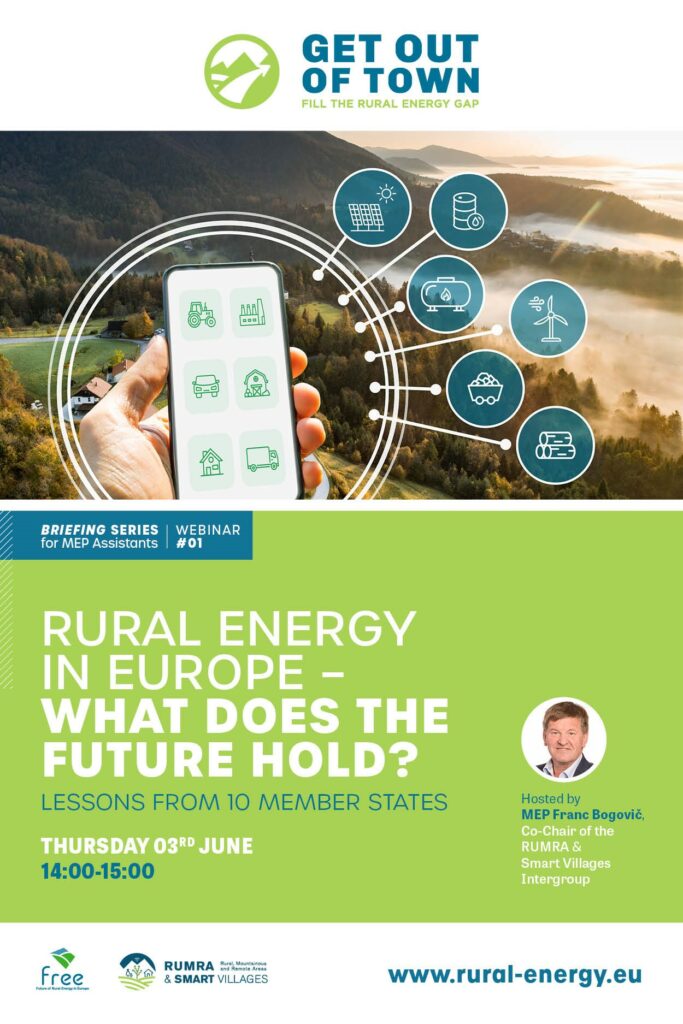Published: 18.06.2021
On 3 June 2021 the RUMRA & Smart Villages Intergroup in the European Parliament & the FREE – Future of Rural Energy in Europe – Initiative launched the webinar series Get out of Town – Fill the Rural Energy Gap. You can watch the full recording of the event here.
During this first session entitled, Rural Energy in Europe – What does the future hold?, Robert Honeyman, Head of Analysis, Low Carbon Business Unit at Gemserv presented the findings of his study entitled Rural Energy Challenges: Lessons from 10 Members States. You can find all the data-driven work conducted by the FREE initiative here, as well as specific country data here.
The webinar, aimed at MEPs, MEP assistants and civil society members of the Intergroup, focused on highlighting key rural energy challenges & potential solutions. It was hosted by MEP Franc Bogovič, Co-Chair of the RUMRA & Smart Villages Intergroup. The expert panel discussion included MEP Sean Kelly, member of the ITRE Committee, Robert Honeyman, Head of Analysis, Low Carbon Business Unit at Gemserv and author of the FREE study, Stefan Schmidt, Public Affairs Manager at Primagas Energie, provider of off-grid energy, and Silvia Estivill, representing the FREE Initiative. The event was moderated by Adam Mouchtar, Special Advisor on Smart Villages at the European Parliament.
MEP Bogovič opened the session by pointing out that rural communities are disadvantaged when it comes to energy choice. He noted that European citizens living in rural areas face a reduced, costly, and often polluting and carbon-intensive choice to meet their energy needs, as well as an older and hard to heat or treat housing stock. MEP Bogovič stressed the importance of the upcoming Fit for 55 package that the European Commission is set to publish mid-July. This package, in connection with the EU Green Deal, is expected to tackle energy in rural areas, guaranteeing connectivity and energy efficiency. He also highlighted that the upcoming Long Term Vision for Rural Areas will be a strategic paper that will address smart villages and the energy sector in rural areas.
Robert Honeyman kicked off his presentation by explaining the great challenge of a net zero emissions target by 2050. 10,000 days are left until 2050, while in Europe 35 to 42 million homes rely on high-carbon fossil fuels such as heating oil and coal. As 85 to 95% of houses will still be standing in 2050, the challenge will be to renovate and allow these homes to switch away from carbon intensive heating solutions. He reiterated that rural areas face specific challenges, as the building stock is typically older and less energy efficient, as shown in the FREE study. To achieve carbon neutrality, he stated that a mixed technology approach is needed. This entails offering to consumers convenient and cost-effective solutions that work for everyone. Indeed, the study showed that energy poverty remains a problem in rural areas across Europe. You can find a video summarizing the conclusions of the study here.
When addressing ways of ensuring decarbonisation in rural areas, MEP Sean Kelly noted that households must stop using coal and other carbon intensive fuels such as heating oil as source of heating. Legislation is key to guarantee the transition, he added. In this sense, he welcomed the Fit for 55 package and the EU zero target goals but stressed that we should also think in the short term and to compel Member States to do the necessary to ensure decarbonisation every year. MEP Kelly showed confidence that the necessary technology to have a transition towards renewable energies is in place and keeps developing.
Stefan Schmidt welcomed the study carried out by Robert Honeyman and signalled that a data-driven approach helps identifying the ways of improving the energy transition. He pointed out that rural consumers often feel left behind because their needs are not taken into account. They face high costs and lack of funding when it comes to renovating their heating systems. Besides, they suffer from energy poverty, as shown in the study. As an alternative, conventional or bio LPG, which are clean burning gases, have proven to reduce carbon emissions by a 90% and can be used with the existing infrastructures, he explained.
Silvia Estivill closed the discussion by outlining the specific needs of rural areas, which deserve tailored measures since they have an old building stock that relies heavily on oil and coal for heating. The ensuing air pollution brings negative consequences for citizen’s health in rural areas. She also explained that energy poverty, with millions of Europeans being unable to afford thermal comfort, requires that EU institutions deliver a just energy recovery by taking into account these needs. This should be the spirt of the EU Renovation Wave, which should contribute to the roll out of cost effective solutions. Incentives should be available to face out high-intensive carbon systems, she concluded.
The RUMRA & Smart Villages Intergroup in the European Parliament and the FREE Initiative would like to extend their thanks to the speakers for sharing their insights on this important topic. We look forward to our second webinar, which will take place in September in collaboration with another member of the Intergroup: CEJA, the Council of the European Young Farmers, and which will focus on Decarbonising agriculture: quick wins with cost-effective and available solutions. The FREE Initiative is also conducting a Rural Barometer study to better understand the specific needs of European citizens living in rural areas. It will be shared following the publication of the Long-Term Vision for Rural Areas.


Recent Comments